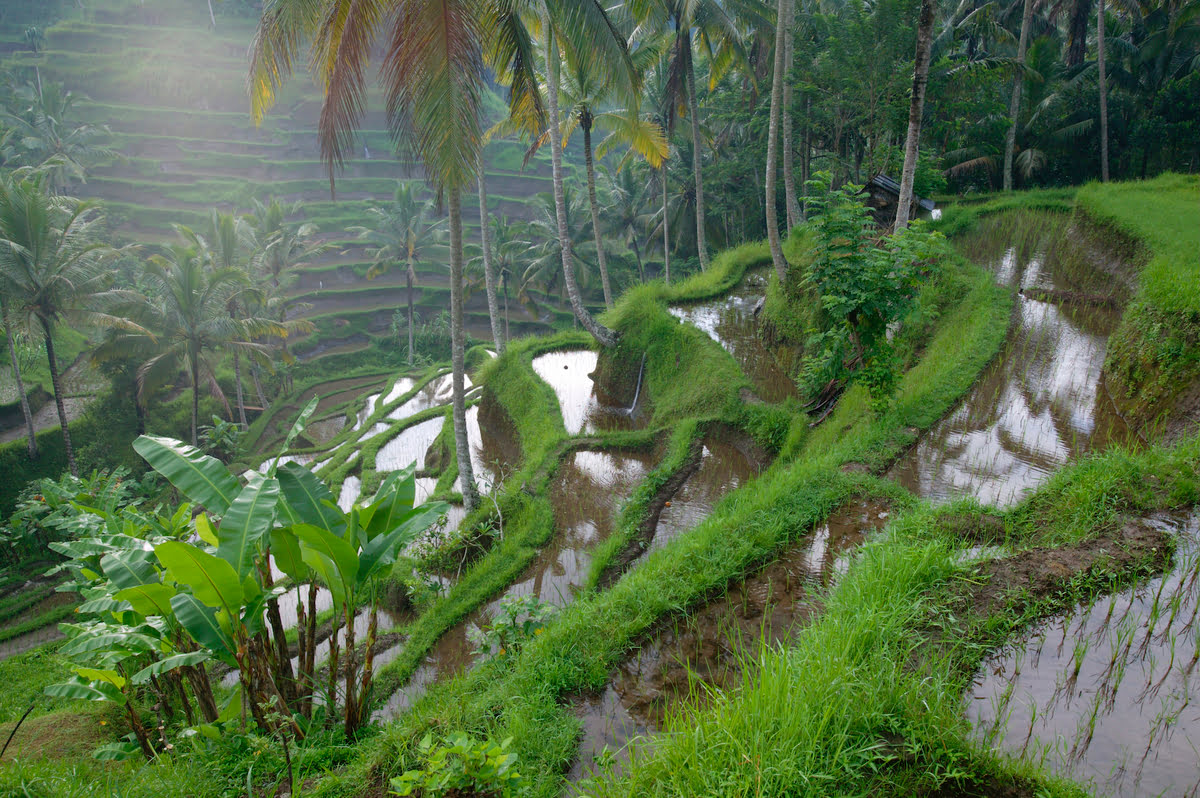Home>Gardening News and Trends>Latest News>What Did Irrigation Do To The Land And The Developing Civilization?


Latest News
What Did Irrigation Do To The Land And The Developing Civilization?
Modified: February 6, 2024
Discover the impact of irrigation on land and civilization in the latest news. Unearth how this practice transformed landscapes and influenced the growth of developing societies.
(Many of the links in this article redirect to a specific reviewed product. Your purchase of these products through affiliate links helps to generate commission for Chicagolandgardening.com, at no extra cost. Learn more)
Table of Contents
Introduction
Throughout history, irrigation has played a fundamental role in shaping the development and progress of human civilizations. It has enabled societies to thrive in regions with limited water resources, transforming arid landscapes into fertile lands capable of sustaining agricultural activities. The practice of irrigation involves the controlled supply of water to crops, ensuring their growth and productivity. While irrigation has undoubtedly been a driving force behind agricultural advancements and societal growth, it is essential to understand the intricate relationship between irrigation, the land, and the development of civilizations.
From the earliest civilizations in Mesopotamia and Egypt to the advanced societies of ancient China and the Indus Valley, the establishment of irrigation systems was vital for sustaining large populations and enabling surplus food production. These irrigation systems were marvels of engineering, utilizing techniques such as canals, reservoirs, and levees to redirect and store water for agricultural purposes. By harnessing the power of irrigation, civilizations were able to expand their agricultural output, support growing populations, and drive economic development.
However, the impact of irrigation on the land and the surrounding ecosystems is not without consequences. While irrigation can lead to increased agricultural productivity, it also presents challenges that need to be addressed for sustainable land use. This article will delve into the various aspects of irrigation’s impact on the land and how it has influenced the development of civilizations.
History of Irrigation
The history of irrigation can be traced back thousands of years, with evidence of early irrigation systems found in ancient civilizations across the globe. One of the earliest known societies to practice irrigation was the Sumerians in Mesopotamia, present-day Iraq, around 6000 BCE. These early farmers relied on irrigation to cultivate crops in the arid regions between the Tigris and Euphrates rivers.
In ancient Egypt, the Nile River played a vital role in the development of one of the most advanced irrigation systems of its time. The annual flooding of the Nile provided nutrient-rich silt that rejuvenated the soil, enabling farmers to grow bountiful harvests. The Egyptians constructed canals, dikes, and basins to control and distribute water for irrigation purposes.
In China, the history of irrigation dates back to the Yellow River civilization, where complex irrigation systems were developed to support rice cultivation. The ancient Chinese engineers built intricate networks of canals and ditches, utilizing water wheels and other innovative techniques to irrigate vast areas of farmland.
Similarly, the Indus Valley civilization, located in what is now modern-day Pakistan and India, depended on irrigation to sustain their agricultural practices. The Indus Valley inhabitants engineered sophisticated irrigation networks, including canals, reservoirs, and diversion channels, to harness the waters of the Indus River for irrigation purposes.
These early civilizations recognized the importance of irrigation in transforming barren lands into productive agricultural areas. They understood that a reliable and controlled water supply was crucial for the success and growth of their societies, allowing them to settle in areas that would have otherwise been uninhabitable.
As time progressed, advancements in irrigation technology were made. In the 8th century BCE, the Assyrians developed newly designed canals and water storage systems. The Romans, known for their engineering prowess, constructed elaborately engineered aqueducts to transport water for irrigation and domestic use.
The history of irrigation is filled with remarkable feats of engineering and ingenuity as civilizations adapted their techniques and technologies to suit their geographical and environmental conditions. These early developments laid the foundation for irrigation practices that continue to evolve and shape our world today.
Impact of Irrigation on Land
Irrigation has undoubtedly been instrumental in increasing agricultural productivity and enabling human settlements in arid regions. However, it also has significant impacts on the land and the surrounding ecosystems. Understanding these impacts is crucial for sustainable land management and ensuring the long-term viability of irrigation practices.
One of the major consequences of irrigation is soil compaction. The constant application of water and the use of heavy machinery in irrigation systems can lead to the compression of soil particles. This compression reduces soil porosity, impairs root penetration, and hampers water and air movement within the soil. Over time, soil compaction can result in reduced fertility, decreased crop productivity, and increased susceptibility to erosion.
Furthermore, extensive irrigation can lead to soil degradation. The constant wetting and drying of soil can cause the breakdown of soil structure, reducing its ability to hold nutrients and support plant growth. Additionally, over-irrigation can cause the leaching of essential nutrients, such as nitrogen and phosphorus, from the soil, contributing to nutrient depletion and imbalances. These factors can severely impact the long-term sustainability of agricultural systems.
Changes in ecosystems are another significant impact of irrigation on land. As water is redirected from its natural course to irrigate fields, natural habitats and wetlands can be disrupted or destroyed. This alteration of ecosystems can lead to the loss of biodiversity and the disruption of ecological processes, negatively affecting wildlife populations and the overall balance of the ecosystem.
Irrigation practices can also contribute to waterlogging and salinization of soil. When excessive amounts of water are applied to the land, it can saturate the soil and lead to waterlogging. Waterlogged soils become poorly aerated, depriving plant roots of oxygen. This results in reduced crop yields and can even lead to the death of plants. Additionally, the excessive use of irrigation water can lead to the accumulation of salts in the soil, negatively impacting plant growth and productivity.
While irrigation has undoubtedly played a critical role in increasing agricultural production and supporting human settlements, it is essential to address its impact on the land. Sustainable irrigation practices, such as precise water management, soil conservation techniques, and effective drainage systems, can help mitigate these negative effects and ensure the long-term viability of irrigated lands.
Soil Compaction and Degradation
One of the significant impacts of irrigation on the land is soil compaction and degradation. Soil compaction occurs when the soil particles are compressed, reducing its porosity and impairing its ability to retain water and nutrients. Irrigation practices, especially those that involve heavy machinery or excessive water application, can contribute to soil compaction, leading to several detrimental effects.
When the soil becomes compacted, its structure is altered, leading to reduced pore space. This leads to poor water infiltration and drainage, as well as limited air movement within the soil. As a consequence, plant roots struggle to penetrate the compacted soil, limiting their access to necessary water and nutrients. This can hinder root development and overall plant growth.
Moreover, compacted soils are more susceptible to erosion. With reduced pore space and poor water infiltration, rainfall or irrigation water is more likely to run off the surface rather than being absorbed into the soil. This runoff causes soil erosion, resulting in the loss of topsoil, which is rich in organic matter and essential nutrients for plant growth. Soil erosion also leads to the degradation of surrounding ecosystems and can have adverse effects on water quality.
In addition to soil compaction, irrigation practices can contribute to soil degradation. The continuous wetting and drying cycles associated with irrigation can cause the breakdown of soil aggregates, resulting in soil structure deterioration. This can lead to the loss of soil organic matter, decreased fertility, and reduced nutrient-holding capacity.
Another factor contributing to soil degradation is over-irrigation, which can lead to the leaching of essential nutrients from the soil. When excess water is applied, it can carry away nutrients such as nitrogen and phosphorus, depriving the soil of these vital elements necessary for plant growth. This nutrient depletion can result in imbalanced soil fertility and reduced crop productivity.
To mitigate soil compaction and degradation, sustainable practices should be implemented. One such practice is conservation tillage, which involves minimizing soil disturbance during planting and harvesting. This helps maintain soil structure and reduce soil compaction. Additionally, precision irrigation techniques, such as drip irrigation or sprinkler systems, can limit water application, preventing excessive soil saturation and waterlogging.
Implementing cover crops and crop rotation can also improve soil health and prevent erosion. These practices help to build soil organic matter, improve soil structure, and maintain nutrient balance. Furthermore, proper soil management, including regular soil testing and nutrient application based on recommendations, is crucial to ensure optimal soil health and fertility.
By addressing soil compaction and degradation through sustainable irrigation and soil management practices, farmers and landowners can preserve soil health and productivity for future generations.
Changes in Ecosystems
Irrigation practices have significant impacts on the surrounding ecosystems, leading to changes in natural habitats and biodiversity. As water is redirected from its natural course to irrigate agricultural fields, it can disrupt or destroy natural ecosystems, resulting in ecological disturbances.
One of the primary consequences of irrigation on ecosystems is the alteration of water availability and flow patterns. The diversion of water for irrigation purposes can lead to reduced water availability downstream, affecting wetlands, rivers, and other bodies of water that rely on natural water flows. This reduction in water availability can have far-reaching effects on aquatic plant and animal species that depend on these water sources for their survival.
Additionally, the construction of irrigation canals, reservoirs, and other infrastructure can fragment habitats and disrupt the natural movement of species. These changes in landscape composition and connectivity can isolate populations, leading to genetic bottlenecks and reduced biodiversity. The loss of biodiversity can have cascading effects on entire ecosystems, disrupting ecological processes and compromising the stability and resilience of natural systems.
Furthermore, the alteration of water availability through irrigation can lead to changes in the composition of plant species in riparian zones and wetlands. These areas that once provided critical habitats for a diverse array of flora and fauna may become more limited in their ability to support specialized species, leading to a decline in biodiversity.
The decline in biodiversity associated with irrigation practices can also have implications for pollination and natural pest control. Many plant species rely on insects, birds, and other animals for pollination, and the loss of these species due to habitat fragmentation or changes in plant composition can hinder reproduction and seed dispersal. Additionally, the disruption of natural pest control mechanisms can result in increased pest pressure and the need for more chemical interventions to protect crops.
To mitigate the adverse effects of irrigation on ecosystems, it is important to implement sustainable practices. One such practice is the restoration and conservation of riparian zones and wetlands. By creating buffer zones along water bodies and protecting these critical habitats, it is possible to preserve biodiversity and maintain ecological connectivity.
Furthermore, implementing water management strategies that prioritize environmental flows can help maintain water availability for natural systems. This involves ensuring that sufficient amounts of water are left in rivers and wetlands to support aquatic biodiversity and ecosystem functioning.
By considering the impacts of irrigation on ecosystems and implementing sustainable practices, it is possible to minimize the negative effects and promote the coexistence of agricultural production and healthy ecosystems.
Waterlogging and Salinization
Waterlogging and salinization are significant challenges associated with irrigation practices, particularly in regions with high water tables and saline soils. These issues can negatively impact agricultural productivity and soil health, posing significant challenges to sustainable land management.
Waterlogging occurs when excessive irrigation water accumulates in the soil, saturating it beyond its capacity to drain. This condition leads to a reduced availability of oxygen in the soil, which is essential for root respiration and nutrient uptake by plants. Consequently, waterlogged soils can hinder root development, resulting in reduced crop yields and increased susceptibility to diseases.
Furthermore, waterlogged soils can lead to the depletion of essential nutrients. The excess water can flush away valuable nutrients, including nitrogen, phosphorus, and potassium, from the root zone, making them less available for plant uptake. This nutrient loss can result in nutrient deficiencies and imbalances, further impacting crop growth and productivity.
Salinization is another consequence of improper irrigation practices. When irrigation water contains high levels of dissolved salts, and evaporation exceeds precipitation, the salts can accumulate in the soil over time. As the salt concentration increases, it becomes toxic to plants, hindering their ability to take up water and nutrients. This can lead to stunted growth, reduced yields, and even plant death.
In addition, saline soils have altered physical properties, making them more compacted and less permeable. This exacerbates the issue of waterlogging as water is unable to infiltrate and drain efficiently. The combination of waterlogging and salinization can have a devastating impact on agricultural productivity, rendering once-fertile lands unproductive.
Addressing waterlogging and salinization requires proper irrigation management and drainage systems. Efficient water management techniques, such as scheduling irrigation based on soil moisture levels and crop needs, can help reduce the risk of waterlogging. Additionally, implementing drainage systems, such as subsurface drainage or open ditches, can help remove excess water from the root zone, preventing waterlogging.
To combat salinization, practices such as leaching and soil amendments can be employed. Leaching involves the application of excess water to flush out accumulated salts from the soil profile. This process helps restore soil fertility and minimize salt stress on crops. Soil amendments, such as gypsum, can also be used to improve soil structure and increase the leaching efficiency.
Proper water and soil monitoring are crucial in identifying the early signs of waterlogging and salinization. Regular soil testing can help assess nutrient availability and salinity levels, enabling timely management interventions. Implementing precision irrigation techniques, such as drip irrigation or sprinkler systems, can also help deliver water directly to the root zone, minimizing the risk of waterlogging and salinization.
By adopting appropriate irrigation and drainage practices, farmers can mitigate the negative impacts of waterlogging and salinization on agricultural productivity and ensure the sustainable use of irrigated lands.
Effects on Agricultural Productivity
Irrigation plays a vital role in enhancing agricultural productivity by providing crops with the necessary water for growth and development. However, improper irrigation practices can have detrimental effects on agricultural productivity, affecting crop yields and overall farm profitability.
One of the primary consequences of inadequate irrigation management is water stress. Insufficient water supply can lead to crop water deficits, impacting plant growth, fruit development, and overall yield. Water stress can result in reduced photosynthesis rates, stunted growth, premature senescence, and even plant death. Additionally, water stress can increase the susceptibility of plants to diseases and pests, further compromising crop productivity.
Conversely, over-irrigation can also negatively impact agricultural productivity. Excessive water application can lead to waterlogging, as mentioned earlier, which limits oxygen availability to plant roots and hinders nutrient uptake. Waterlogged soils can cause root asphyxiation and nutrient deficiencies, resulting in decreased crop yields. The leaching of nutrients due to over-irrigation can also lead to nutrient imbalances, affecting plant health and productivity.
Moreover, inefficient water distribution in irrigation systems can result in uneven moisture levels across fields. Areas with inadequate water supply may experience drought stress, while areas with excessive water may suffer from waterlogging and plant stress. This non-uniform distribution of water can lead to variability in crop growth and yield, reducing overall productivity.
Salinization, as a consequence of irrigation, can also have detrimental effects on agricultural productivity. High soil salinity levels can inhibit nutrient uptake by plants, impairing their growth and productivity. Furthermore, salt stress can cause physiological imbalances in crops, leading to reduced yields and poor-quality produce.
In addition to the direct impact on crops, inadequate irrigation practices can have indirect effects on agricultural productivity. Water scarcity or improper water management can lead to the loss of valuable irrigation water, decreasing the availability of water for agricultural purposes. This heightens competition for water resources and can result in reduced crop area or the need to shift to less water-intensive crops, affecting overall farm profitability.
Addressing the effects on agricultural productivity requires implementing efficient irrigation techniques. Precision irrigation methods, such as drip irrigation or sprinkler systems, can help deliver water directly to the root zone, minimizing water losses and ensuring more uniform water distribution. Additionally, the use of weather-based irrigation scheduling and soil moisture monitoring can help optimize water application, avoiding over- or under-irrigation.
Furthermore, proper soil management practices, including soil testing and nutrient management, can optimize nutrient availability and support healthy plant growth. Soil amendments can be used to mitigate the adverse effects of salinity on crop productivity, enhancing soil fertility and reducing salt stress.
By adopting sustainable irrigation practices and ensuring efficient water and nutrient management, farmers can enhance agricultural productivity, improve crop yields, and promote long-term farm sustainability.
Role in Developing Civilizations
Irrigation has played a pivotal role in the development and progress of human civilizations throughout history. It has enabled societies to flourish in regions with limited water resources, transforming arid landscapes into fertile lands capable of sustaining agricultural activities. The practice of irrigation has been instrumental in supporting the growth of civilizations by providing a stable food supply, supporting population growth, and driving economic development.
One of the key contributions of irrigation to developing civilizations was its ability to increase agricultural productivity. By redirecting water to arid regions, irrigation allowed for the cultivation of crops that would otherwise not thrive in such environments. This surplus in food production not only ensured the survival of growing populations, but it also provided the opportunity for specialization and the development of complex societal structures.
Moreover, irrigation systems allowed for the establishment of settled communities and the transition from nomadic lifestyles to sedentary agricultural-based societies. Reliable access to water for crop cultivation meant that communities no longer had to constantly move in search of fertile land and water sources. This stability facilitated the development of permanent settlements, which served as the foundation for the growth of civilizations.
Furthermore, the construction and maintenance of elaborate irrigation systems required advanced engineering knowledge and the establishment of social hierarchies. The need to manage water resources and develop intricate networks of canals and irrigation channels necessitated organization and coordination among communities. This led to the emergence of social structures, specialized labor, and leadership roles within developing civilizations.
Irrigation also played a crucial role in the growth of trade and commerce. The surplus in agricultural production made possible by irrigation allowed civilizations to generate excess goods that could be traded with neighboring communities. This exchange of goods and resources not only fueled economic development but also fostered cultural exchange, further contributing to the growth and advancement of societies.
Additionally, the agricultural surplus made possible by irrigation systems provided the foundation for the development of other industries and technologies. The availability of surplus food allowed individuals to pursue other occupations, such as craftsmanship, trade, and the development of arts and sciences. This diversification of industries and the advancement of knowledge propelled civilizations forward, creating the conditions for further growth and innovation.
Throughout history, the impact of irrigation on developing civilizations cannot be overstated. It has been a driving force behind the transition from nomadic lifestyles to settled agriculture, the growth of populations, the establishment of social hierarchies, and the development of economies and trade. The use of irrigation systems has laid the foundation for the development of technologically advanced societies and shaped the course of human history.
Irrigation and Social Organization
Irrigation has not only transformed landscapes and supported agricultural development but has also played a significant role in shaping social organization within communities and civilizations throughout history. The construction, maintenance, and management of irrigation systems have required coordination, collaboration, and the establishment of social structures to ensure efficient water distribution and effective land use.
One of the key impacts of irrigation on social organization is the emergence of communal labor and collective responsibility. The construction of irrigation infrastructure necessitated the pooling of labor and resources from the community. This resulted in the development of shared labor systems, where community members would come together to build and maintain irrigation canals, reservoirs, and other infrastructure. This communal effort fostered a sense of collective responsibility and solidarity within communities, leading to the establishment of social hierarchies and the emergence of leadership roles overseeing irrigation activities.
Moreover, the management of water resources required coordination and decision-making. Community-based institutions or systems of governance were established to regulate water distribution, ensure fairness, and resolve conflicts. Water rights and governance structures were developed to manage and allocate water resources, creating social institutions and legal frameworks surrounding irrigation practices. These institutions reinforced social order and maintained the equitable distribution of water among community members, supporting stability and cooperation within the society.
The need for effective water management also played a significant role in the development of social stratification and the allocation of power. Those who held knowledge about irrigation techniques and water management methods often possessed a considerable amount of influence within the community. The accumulation of knowledge and expertise in irrigation fostered specialization, leading to the emergence of skilled individuals who could provide guidance and leadership in managing irrigation systems. This specialization created social hierarchies where individuals with expertise in irrigation assumed leadership positions and held significant societal influence.
In some cases, the importance of irrigation in sustaining agricultural production led to the centralization of power and the establishment of governing bodies. Ancient civilizations such as Egypt, Mesopotamia, and the Indus Valley developed sophisticated irrigation systems overseen by centralized authorities. These authorities played a crucial role in managing irrigation infrastructure, allocating water resources, and ensuring the equitable distribution of water throughout the society. The centralized control over irrigation resources also strengthened political authority and centralized governance within these civilizations.
Furthermore, irrigation systems facilitated economic development and trade, leading to increased social interactions and cultural exchange. The surplus agricultural production made possible by irrigation fostered specialized economic activities and the growth of marketplaces. This exchange of goods and resources not only facilitated economic growth but also brought people from different backgrounds together, fostering diverse social interactions and the exchange of ideas and knowledge.
In summary, irrigation has shaped social organization by fostering communal labor, the emergence of social hierarchies, the development of institutions for water governance, and the centralization of power. The construction and management of irrigation systems have not only influenced agricultural productivity but have also played a pivotal role in shaping social structures, governance systems, and cultural dynamics within societies.
Technological Advancements and Irrigation
Technological advancements have played a crucial role in the evolution of irrigation practices, leading to improved efficiency, increased water savings, and enhanced agricultural productivity. Over the years, innovations in irrigation technology have revolutionized the way water is delivered to crops, ensuring optimal water management and sustainable use of this precious resource.
One significant technological advancement in irrigation is the development of drip irrigation systems. Drip irrigation delivers water directly to the root zone of plants through a network of tubes and emitters. This targeted water delivery system reduces water losses due to evaporation and runoff, resulting in significantly higher water use efficiency. Drip irrigation systems also allow for the precise application of water and nutrients, enabling farmers to meet the specific needs of each crop, resulting in improved yields and reduced water requirements.
Another notable advancement is the adoption of sprinkler irrigation systems. Sprinkler systems use overhead sprinklers or spray nozzles to distribute water over the field, mimicking natural rainfall. These systems ensure uniform water distribution and are particularly effective in areas with high temperature, windy conditions, or uneven terrain. The use of modern sprinkler technologies, such as low-pressure systems and precision nozzles, helps minimize water waste and maximize the efficiency of water application.
Furthermore, the utilization of remote sensing and precision agriculture technologies has greatly influenced irrigation practices. Remote sensing allows for the monitoring of crop water stress, soil moisture, and plant health, providing valuable data for decision-making regarding irrigation scheduling and water allocation. The integration of remote sensing with geographic information systems (GIS) enables farmers to have real-time information on soil moisture levels and crop water requirements, allowing for precise irrigation management based on field conditions.
The advancement of irrigation control systems, such as automated irrigation controllers and soil moisture sensors, has also contributed to more efficient water management. These systems enable farmers to automate the irrigation process based on real-time data, reducing the risk of over- or under-irrigation. Soil moisture sensors provide accurate information on the moisture content of the soil, allowing for precise irrigation scheduling based on the actual needs of the plants.
Additionally, the use of mobile applications and cloud-based platforms has enhanced communication and data management in irrigation. These technologies allow farmers to access information on precipitation, evapotranspiration rates, and crop water requirements from their mobile devices. Farmers can make informed decisions about irrigation scheduling, adjust irrigation plans, and optimize water use efficiency, all in real-time.
Overall, technological advancements have transformed irrigation practices, making them more efficient, sustainable, and precise. These innovations empower farmers to make informed decisions regarding water management, optimize crop production, and conserve water resources. As technologies continue to evolve, there is a promising future for further advancements in irrigation, enabling even more efficient use of water and increased agricultural productivity.
Conclusion
Irrigation has played an indispensable role in shaping the development of human civilizations throughout history. From the earliest civilizations to the present day, the practice of irrigation has transformed arid landscapes into thriving agricultural lands, supporting food production, population growth, and economic prosperity. However, the impact of irrigation on the land and the surrounding ecosystems should not be overlooked.
Irrigation can lead to soil compaction and degradation, changes in ecosystems, waterlogging, and salinization. These factors can have severe consequences for agricultural productivity and the long-term sustainability of irrigated lands. It is crucial to implement sustainable practices to mitigate these negative effects, such as precision irrigation techniques, soil conservation methods, and efficient water management strategies.
Furthermore, irrigation has had a profound influence on the social organization and development of civilizations. It has facilitated the emergence of communal labor, the establishment of social hierarchies, and the creation of institutions for water governance. The construction and management of irrigation systems have played a vital role in establishing settled communities, supporting economic growth, and fostering cultural exchange.
Technological advancements have also played a critical role in improving irrigation practices. Innovations such as drip irrigation, sprinkler systems, remote sensing, and precision agriculture technologies have enhanced water management, increased water use efficiency, and enabled precise irrigation scheduling based on real-time data.
As we move forward, it is essential to continue prioritizing sustainable irrigation practices that conserve water resources, protect the environment, and ensure food security. The integration of technological advancements will play a vital role in optimizing water use and enhancing agricultural productivity. By considering the impacts of irrigation on the land, ecosystems, and social structures, we can strive towards achieving a harmonious balance between agricultural development and environmental conservation.





